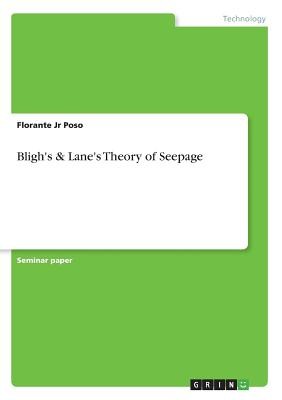
- We will send in 10–14 business days.
- Author: Florante Poso
- Publisher: GRIN Publishing
- ISBN-10: 3668524025
- ISBN-13: 9783668524026
- Format: 14.8 x 21 x 0.2 cm, minkšti viršeliai
- Language: English
- SAVE -10% with code: EXTRA
Reviews
Description
Seminar paper from the year 2017 in the subject Engineering - General, Basics, grade: 1.5, University of Eastern Philippines, course: Civil Engineering, language: English, abstract: To prevent internal erosion and particle migration, control of seepage pressures and velocities must be given due consideration in the design of hydraulic structures. The percolation length (seepage) for a foundation can be determined by using various methods. There are number of methods available to analyze the problem on seepage and uplift pressure, and one of which is Bligh's theory of creep. Other methods are Lane's Method, Kosla's Theory and Flow nets. Based on Bligh's theory, that along the bottom contour of the structure, the water creeps, and the percolation length (seepage) can be determined. Lane's theory was patterned from the Bligh's creep theory but according to Lane, Bligh had only calculated the total length of creep by adding both the horizontal and vertical length of creep and part of its limitation is it does not make any distinction between the two creeps. Some experts had criticized Lane's method due to the fact that it is an empirical method and not based on any mathematical approach. However, the method is also widely used due to the simplicity on its approach.
EXTRA 10 % discount with code: EXTRA
The promotion ends in 23d.15:36:55
The discount code is valid when purchasing from 10 €. Discounts do not stack.
- Author: Florante Poso
- Publisher: GRIN Publishing
- ISBN-10: 3668524025
- ISBN-13: 9783668524026
- Format: 14.8 x 21 x 0.2 cm, minkšti viršeliai
- Language: English English
Seminar paper from the year 2017 in the subject Engineering - General, Basics, grade: 1.5, University of Eastern Philippines, course: Civil Engineering, language: English, abstract: To prevent internal erosion and particle migration, control of seepage pressures and velocities must be given due consideration in the design of hydraulic structures. The percolation length (seepage) for a foundation can be determined by using various methods. There are number of methods available to analyze the problem on seepage and uplift pressure, and one of which is Bligh's theory of creep. Other methods are Lane's Method, Kosla's Theory and Flow nets. Based on Bligh's theory, that along the bottom contour of the structure, the water creeps, and the percolation length (seepage) can be determined. Lane's theory was patterned from the Bligh's creep theory but according to Lane, Bligh had only calculated the total length of creep by adding both the horizontal and vertical length of creep and part of its limitation is it does not make any distinction between the two creeps. Some experts had criticized Lane's method due to the fact that it is an empirical method and not based on any mathematical approach. However, the method is also widely used due to the simplicity on its approach.


Reviews